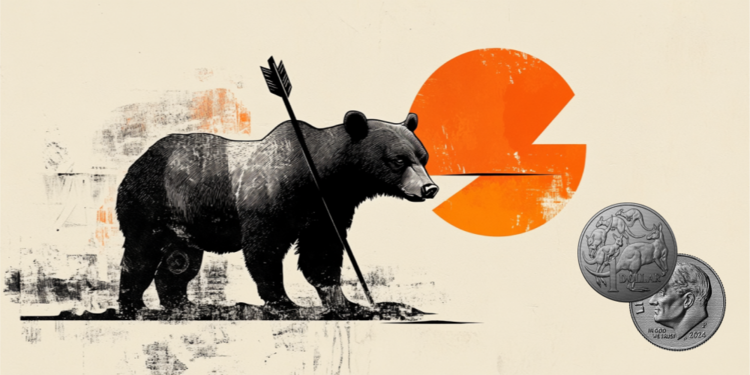The AUD/USD pair trades 0.5% down to near 0.6450 during the European trading session on Friday. The Aussie pair faces intense selling pressure as the Australian Dollar (AUD) underperforms its peers amid growing trade frictions between the United States (US) and China.
Australian Dollar Price Today
The table below shows the percentage change of Australian Dollar (AUD) against listed major currencies today. Australian Dollar was the weakest against the Swiss Franc.
| USD | EUR | GBP | JPY | CAD | AUD | NZD | CHF | |
|---|---|---|---|---|---|---|---|---|
| USD | -0.12% | 0.10% | -0.39% | 0.02% | 0.38% | 0.11% | -0.44% | |
| EUR | 0.12% | 0.24% | -0.28% | 0.16% | 0.56% | 0.23% | -0.32% | |
| GBP | -0.10% | -0.24% | -0.46% | -0.11% | 0.31% | -0.02% | -0.61% | |
| JPY | 0.39% | 0.28% | 0.46% | 0.40% | 0.81% | 0.47% | -0.08% | |
| CAD | -0.02% | -0.16% | 0.11% | -0.40% | 0.37% | 0.08% | -0.52% | |
| AUD | -0.38% | -0.56% | -0.31% | -0.81% | -0.37% | -0.32% | -0.87% | |
| NZD | -0.11% | -0.23% | 0.02% | -0.47% | -0.08% | 0.32% | -0.60% | |
| CHF | 0.44% | 0.32% | 0.61% | 0.08% | 0.52% | 0.87% | 0.60% |
The heat map shows percentage changes of major currencies against each other. The base currency is picked from the left column, while the quote currency is picked from the top row. For example, if you pick the Australian Dollar from the left column and move along the horizontal line to the US Dollar, the percentage change displayed in the box will represent AUD (base)/USD (quote).
Trade tensions between the US and China emerged after Washington imposed additional 100% tariffs on imports from Beijing, which will come into effect from November. Tariff threats from the US came after China announced export control measures on rare earth minerals.
In response, China’s Commerce Ministry has stated that Washington’s interpretation on Beijing’s rare earth export control measures is seriously “distorted and exaggerated”, and clarified that the demand of export licence is mere a regulatory measure, and not a ban on export of critical minerals, Reuters reported.
The impact of uncertainty over China’s economic outlook remains a major drag on the Australian Dollar (AUD), given that the Australia economy relies heavily on its exports to Beijing.
On the domestic front, Reserve Bank of Australia (RBA) dovish bets have accelerated due to an unexpected increase in the jobless rate. In September, the Unemployment Rate rose to 4.5% against estimates and the prior reading of 4.3%.
Meanwhile, the US Dollar Index (DXY) strives to gain ground after posting a fresh 10-day low near 98.00 earlier in the day. The outlook of the US Dollar (USD) remains bearish amid US-China trade tensions and accelerating Federal Reserve (Fed) dovish bets.
US-China Trade War FAQs
Generally speaking, a trade war is an economic conflict between two or more countries due to extreme protectionism on one end. It implies the creation of trade barriers, such as tariffs, which result in counter-barriers, escalating import costs, and hence the cost of living.
An economic conflict between the United States (US) and China began early in 2018, when President Donald Trump set trade barriers on China, claiming unfair commercial practices and intellectual property theft from the Asian giant. China took retaliatory action, imposing tariffs on multiple US goods, such as automobiles and soybeans. Tensions escalated until the two countries signed the US-China Phase One trade deal in January 2020. The agreement required structural reforms and other changes to China’s economic and trade regime and pretended to restore stability and trust between the two nations. However, the Coronavirus pandemic took the focus out of the conflict. Yet, it is worth mentioning that President Joe Biden, who took office after Trump, kept tariffs in place and even added some additional levies.
The return of Donald Trump to the White House as the 47th US President has sparked a fresh wave of tensions between the two countries. During the 2024 election campaign, Trump pledged to impose 60% tariffs on China once he returned to office, which he did on January 20, 2025. With Trump back, the US-China trade war is meant to resume where it was left, with tit-for-tat policies affecting the global economic landscape amid disruptions in global supply chains, resulting in a reduction in spending, particularly investment, and directly feeding into the Consumer Price Index inflation.
Read the full article here


